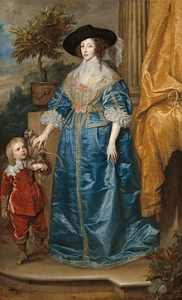Earlier this year I read Frances Quinn’s That Bonesetter Woman, on the strength of a Sunday Times review, and liked it a lot – partly because I’m a sucker for historical novels but mostly because I was intrigued by its unusual subject matter. Well reading is, of course, an unending one-thing-leads-to-another journey so next I scurried off to Quinn’s backlist – where I found The Smallest Man which was published last year,
Obviously I’ve seen reproductions of the van Dyck painting of “the Queen’s dwarf”, Jeffrey Hudson, with Queen Henrietta Maria (National Gallery of Art, Washington) and I’d read accounts of his being presented to her as a gift in a huge pie. Beyond that I’d never given him much thought.
Inspired by what we know about Hudson, Quinn has created Nat Davy, one of the most engaging fictional characters I’ve enjoyed the company of in ages. Born to a humble family in Oakham and then sold by his pretty awful father to the nearby Duke of Buckingham as a gift for the Queen, Davy – fearful, distressed and aged only 11 – arrives at court. There he’s bullied, petted, befriended and gradually grows up.
What follows is a fine Civil War novel from an unusual perspective. Quinn’s take on Henrietta Maria is more sympathetic than many. Through Nat’s eyes, we see a competent, feisty but terrified woman in great danger, desperate to make her husband see sense even when she is in Paris and he remains, stubbornly, in England. Quinn’s rather neat conceit is that Nat, who is fully literate, becomes the trusted confidant who ciphers and deciphers their letters. That means that he and the reader are at the heart of what’s going on.
It’s a novel about disruption – arguably the worst Britain has ever seen with family members often ending up on different sides – with a lot of travel and dislocation. Poor Nat is very loyal – although privately he often tells the reader that he can’t see what the arguments are about. Prayer books and priests seem very minor, really. Along the way he makes two fine friends – Jeremiah who has “giantism” and Henry who has an eye for the girls. And there’s a love story running through the narrative which makes you long to take Nat, who doesn’t value himself, on one side and talk sense to him.

One of the best things in this novel is Quinn’s empathy with Nat’s condition – I hesitate to call it a “disability” because by the last page he certainly wouldn’t have done. Hudson – and thus Nat – was less than two feet tall and that’s tiny even by dwarfism standards. Modern medics tell us that the condition is usually caused by growth hormone deficiency and/or genetic mutation. In the seventeenth century people invented stories about curses, witchcraft and so on to explain what they didn’t understand and were frightened of. Nat, however, is a fully functioning, intelligent male adult who learns to ride a horse and shoots a man dead in a duel. He loathes being picked up or patronised although he cannot run fast or walk too far because of his stature.
Quinn gets the internal conflicts, emotions and anxieties very convincingly. And there’s a splendid first person account of the horrifying events in Whitehall on 30 January 1649. Yes, that’s one of the best documented events in history but by putting Nat there in the crowd, Quinn manages to make it very fresh and vivid.

Next week on Susan’s Bookshelves: Things Fall Apart by Chinua Achebe